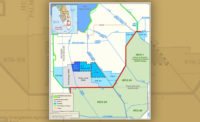Everglades restoration reached a new milestone with two recent developments in the plan for water storage. Construction is scheduled to begin this summer on a reservoir that is key to the health of the Caloosahatchee Estuary, west of Lake Okeechobee. And a study released in June after more than a decade of research found that deep-aquifer storage of freshwater for recovery and discharge is feasible and can help to restore essential water flows in the River of Grass.
Lump-sum bids will be opened on July 30 for site preparation on the Caloosahatchee River West Basin Storage Reservoir, also known as the C-43 Reservoir, on 10,500 acres about five miles southwest of LaBelle, Fla. The site was a citrus farm, and the contract, with an engineer’s estimate of $15 million, covers about 15 million cu yd of earthmoving, demolition of agricultural citrus facilities and installation of settlement-monitoring instrumentation. It is the first of four construction packages to complete one of the reservoir’s cells, the western cell, at an estimated cost of $304 million. Completion of the eastern cell, a fifth contract that has not yet been scheduled, will bring the total cost of the reservoir to about $500 million, says Jeff Kivett, director of operations, engineering and construction for the South Florida Water Management District.
“Underneath the site, there’s a clay layer, which is why it makes a good site for a reservoir,” Kivett says. “The levee has a cutoff wall all the way around it. Wherever we have a structure, whether the pump station or a water-control structure, we need to preload it so we can compress that clay layer before they build the actual structure on it. So, a lot of what we’re doing is, first, clearing the levee footprint and then picking the excess dirt to preload those sites.”
Bids for the second contract, the smaller of two pump stations, will be solicited in January. The third contract, for the intake pump station, is scheduled for a July 2016 solicitation; and the fourth, for the western cell, is slated for a probable late 2016 or early 2017 bid, Kivett says. The western cell will have a nominal capacity of 100,000 acre-ft of storage. Completion of the eastern cell will increase total storage to 170,000 acre-ft.
Stanley Consultants Inc. is the district’s engineer of record and designed the C-43 Reservoir. Stanley is a subcontractor to Carollo Engineers, which, as the prime contractor, serves as the owner’s engineer.
“The C-43 Reservoir is an extremely important project for the Caloosahatchee River,” says Tom Van Lent, Everglades Foundation senior scientist. More than a century of engineering South Florida’s hydrology has altered the water quality, and a principal goal of the Comprehensive Everglades Restoration Plan (CERP) is to get the water right, he notes.
Salinity is “one of the most important parameters. Right now, salinities go from very fresh, when flows are high during the wet season, to very high salinity—seawater,” Van Lent notes.
“More organisms can survive in a moderate salinity. A moderate range of salinities supports a wider variety of plants and animals. So, this reservoir moderates the salinity and improves the water quality of the estuary.”
The reservoir “acts like a wetland,” Van Lent says. “It takes freshwater when there’s a lot of freshwater available, stores it for about six to nine months, then gradually releases it back into the estuary.” Simulations in the plan “include an aquifer storage and recovery [ASR] component, as well,” he says. “That ASR doesn’t change the source of the water, but it does change the capacity of the reservoir, [making] it larger.” Essentially, both perform the same storage function.
A new tool for Everglades restoration will become available following the June completion of a feasibility study of ASR. The report on the study is the culmination of more than a decade of planning, pilot-testing, evaluation and peer review of the system. Used on a relatively small scale by municipal utilities in several states, it has never been implemented on the scale envisaged by Everglades restoration planners.






Post a comment to this article
Report Abusive Comment